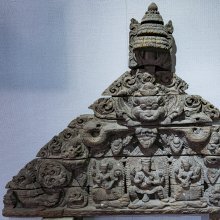Panja, Pañja, Pamja: 6 definitions
Introduction:
Panja means something in Buddhism, Pali, Marathi, Hindi, biology. If you want to know the exact meaning, history, etymology or English translation of this term then check out the descriptions on this page. Add your comment or reference to a book if you want to contribute to this summary article.
Images (photo gallery)
Biology (plants and animals)
Source: Google Books: CRC World Dictionary (Regional names)1) Panja in India is the name of a plant defined with Ceiba pentandra in various botanical sources. This page contains potential references in Ayurveda, modern medicine, and other folk traditions or local practices It has the synonym Eriodendron pentandrum (Linn.) Kurz (among others).
2) Panja is also identified with Pleopeltis macrocarpa It has the synonym Niphobolus lanceolatus Trimen (etc.).
3) Panja is also identified with Rotheca serrata It has the synonym Cyclonema serratum (L.) Hochst. (etc.).
Example references for further research on medicinal uses or toxicity (see latin names for full list):
· Systema Vegetabilium ed. 16 (1826)
· Rev. Revised Handbook to the Flora of Ceylon (1983)
· Flora Yunnanica (1977)
· Mém. Soc. Linn. Paris (1827)
· Novon (1998)
· Sci. & Cult. (1975)
If you are looking for specific details regarding Panja, for example diet and recipes, side effects, pregnancy safety, extract dosage, health benefits, chemical composition, have a look at these references.

This sections includes definitions from the five kingdoms of living things: Animals, Plants, Fungi, Protists and Monera. It will include both the official binomial nomenclature (scientific names usually in Latin) as well as regional spellings and variants.
Languages of India and abroad
Pali-English dictionary
Source: Sutta: The Pali Text Society's Pali-English DictionaryPañja, (is it to be puñja?) heap, pile A. II, 75 (meaning different?); Cp. I. 1016. (Page 389)

Pali is the language of the Tipiṭaka, which is the sacred canon of Theravāda Buddhism and contains much of the Buddha’s speech. Closeley related to Sanskrit, both languages are used interchangeably between religions.
Marathi-English dictionary
Source: DDSA: The Molesworth Marathi and English Dictionarypañja (पंज).—a ( P Five.) Of five years of age--a horse. A term of jockeys and horse-dealers.
--- OR ---
pañjā (पंजा).—m ( P) The five of a suit of cards: also the five on a die: also a cast or turn up of five with dice. 2 (Both ja & dza.) The hand as spread abroad or opened out. A familiar word at the drill. 3 A claw (of a tiger, cat &c.); the hand of a monkey; the iron hand of Muhammadans, representing their five holy personages (); the five-fingered instrument of the gōsāvī &c. 4 A glove. 5 (Incorrectly for paṇajā) A paternal great grandfather.
Source: DDSA: The Aryabhusan school dictionary, Marathi-Englishpañja (पंज).—a (Five.) Of five years of age-a horse. A term of jockeys and horse- dealers.
--- OR ---
pañjā (पंजा).—m The five of a suit of cards: the five on a die. The hand as spread abroad or opened out. A familiar word for the drill. A claw (of a tiger, cat &c.); the hand of a tiger, cat &c.); the hand of a monkey; the iron hand of Mahammedans, representing their five holy personages. Incorrectly for paṇajā.
Marathi is an Indo-European language having over 70 million native speakers people in (predominantly) Maharashtra India. Marathi, like many other Indo-Aryan languages, evolved from early forms of Prakrit, which itself is a subset of Sanskrit, one of the most ancient languages of the world.
Hindi dictionary
Source: DDSA: A practical Hindi-English dictionaryPanja in Hindi refers in English to:—(nm) a claw, paw, forefoot; five fingers or toes; an aggregate of five; playing card having five pips; —[phailana/badhana] to extend one’s hand for gaining control (over); to extend the scope of influence; [pamje mem] firmly under control; [pamjom ke bala calana] to walk on the toes, to walk unnoticed/stealthily..—panja (पंजा) is alternatively transliterated as Paṃjā.
...
Kannada-English dictionary
Source: Alar: Kannada-English corpusPaṃja (ಪಂಜ):—
1) [adjective] amounting to five in number; five.
2) [adjective] being one fifth of.
--- OR ---
Paṃja (ಪಂಜ):—[noun] the cardinal number five.
--- OR ---
Paṃja (ಪಂಜ):—[noun] = ಪಂಜಾ [pamja].
--- OR ---
Paṃjā (ಪಂಜಾ):—
1) [noun] a foot of a bird or any of various reptiles and mammals that has sharp, hooked and curved horny structure or nail; a claw.
2) [noun] a metal hand, representing five holy personages, worshipped by Muslims during Muharram.
--- OR ---
Pāṃja (ಪಾಂಜ):—[noun] any of a number of squirrels (esp. genus Glaucomys) with winglike folds of skin attached to the legs and body, which enable them to make long, gliding leaps; a flying squirrel.
Kannada is a Dravidian language (as opposed to the Indo-European language family) mainly spoken in the southwestern region of India.
See also (Relevant definitions)
Starts with (+267): Pamcati, Pamjamareshime, Pamjamhisse, Pamjapavana, Pamjaravalli, Pamjarisu, Pamjariya, Pamjarulli, Panca-cattakaruvi, Panca-kalyanapucai, Panca-lankalatanam, Panca-ma-cattakaruvi, Panca-makayakam, Panca-makayakkiyam, Panca-makayannam, Panca-mapatakam, Panca-mapatakan, Panca-mukamuttirai, Panca-mukavattiyam, Panca-nakakurmaiyon.
Ends with: Baghapanja, Chakkapanja, Chhakkapanja, Dhalepanja, Garur panja, Garurpanja, Hathapanja, Hathpanja, Kaipamju, Nipanja, Saalab panja, Saalampanja, Salab-panja, Salam panja, Salampanja, Salem-panja, Spanja, Uparapanja.
Full-text: Pamja, Garur panja, Salab-panja, Saalab panja, Panjadi, Salaab panja gulabi, Salaab panja safed, Salam panja, Ashurkhana, Pacakaranem, Panjamanja, Salem-panja, Panj, Panjara, Chhakka, Sodavinem, Panca.
Relevant text
Search found 2 books and stories containing Panja, Pañja, Pamja, Pañjā, Paṃja, Paṃjā, Panjā, Pāṃja, Pāñja, Pānja; (plurals include: Panjas, Pañjas, Pamjas, Pañjās, Paṃjas, Paṃjās, Panjās, Pāṃjas, Pāñjas, Pānjas). You can also click to the full overview containing English textual excerpts. Below are direct links for the most relevant articles:
Buddhist records of the Western world (Xuanzang) (by Samuel Beal)
Chapter 24 - Country of Kiu-mi-to (Kumidha or Darwaz and Roshan) < [Book I - Thirty-Four Countries]
Related products

